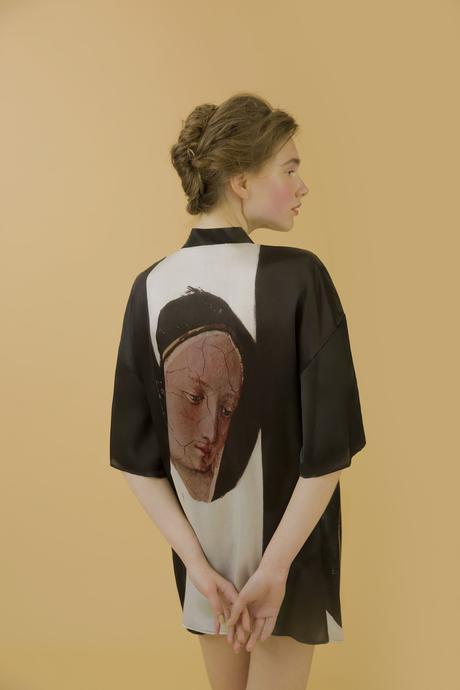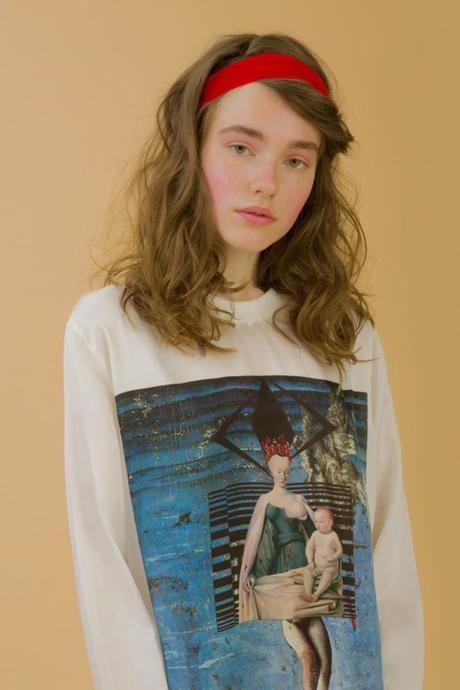Established by Ersi Liakouri, HERSE is a high-end artware brand, carving its own niche in the wearable art industry. A graphic designer by training, Liakouri worked for eight years in advertising, before deciding it was time to embark on a new creative venture that would combine art – her lifelong passion – with graphic design and fashion. By reconstructing established art, she aspires to make it a part of everyday life. Her artwork is imprinted on luxurious fabrics, and each design produced is a unique, individually numbered piece of modern art, automatically making its owner a “collector” – a concept developed by the brand. Find out as we speak with the HERSE founder about presenting her work as art, working with a diversed stockists network and expanding her brand.

Tell us a bit about your background and what led you to starting HERSE.
Through HERSE, I strive to act as a reformist of established art, transforming it into a culturally loaded element of everyday life. I felt the urge to take art out of the formalin of museums, and to revitalize old masterpieces by fusing them with modern movements.
I was lucky to study Graphic Design, and get a BA from the University of Wales, and then to be exposed to the constantly creative environment of a well-known multinational advertising group for about eight years. Then, I felt ready to follow my passion for art, blending it with graphic design and fashion. In my works, I try to capture the human elements of life, in order to provoke and stimulate positive emotions.

How did you decide that scarves and tops are garments best suited for wearable art in your case?
Scarves mainly, but also tops, provide wide spaces to deploy the designs. So, since the visual art syntheses are the core element of HERSE, it is only natural that these garments have been chosen to play the role of our extravagant canvas. Then, I realized that these garments are used to enfold the seven chakras, as described in Eastern spiritual traditions.

Could you please elaborate on the inspiration behind the artwork and the raw materials you work with?
The endeavor is to express the antithesis between the established finesse of the undisputed sophistication of fine craftsmanship, as embodied in the luxury textiles I use, with the revolutionary and innovative spirit that is inherent in great art. The synthesis of the two represents the constant evolution in human perception of the world simultaneously with the continuous development of aptitude and technic.

How often do you introduce new designs to your collection? Are any art movements associated with particular seasons?
About 50 designs are released every year. Since each garment is produced in pre-specified limited numbers, they stay around only for the time needed to reach their final owner.
The current HERSE creations express a resolute attitude, getting inspiration from Surrealism to Pop Art and Italian Renaissance. One can find Naturalism and Pop Art influences in “Golden Marilyn” kimono, or get attracted by “Aphros” scarf, which was inspired by ancient poet Sappho’s hymn to Aphrodite. I think that these creations celebrate femininity, each in different mood, expressed on 100% fine silk, so they can be used in all seasons.

HERSE retail points include popular lifestyle destinations but Saatchi Art as well. What made you think they could be a good fit for your brand? How are you working towards expanding your retail network?
In HERSE, we seek to balance classy with unconventional. We are trying to break the walls between art – as it is immobilized in traditional museums – and the vividness of real life. We try to connect different artistic movements, to bridge the gap of time between artworks.
In view of this, we think that people should have access to HERSE all the same in art galleries and museum shops, luxury boutiques and spiffy concept stores, yachting marinas and busy airports, five star hotels and selective e-shops.

You have introduced the concept of HERSE “collectors.” How is presenting your work as art aiding, or in some cases obstructing, your brand sales?
The idea behind limiting the production of each item and “personalizing” it with a unique, identifiable code aims to address two issues: each HERSE design can be accessed by more than one person at an affordable price, which would not have been possible, if it was offered as a prototype work of art; our second thought was to initiate an evolution of the pre-owned garments trend, with the underling concern about the planet and recycling. We are not looking for the mass market anyhow. Instead, we would be satisfied if ten years from now, an item of the 2017 collection could be resold at a price higher than that of today.

In my opinion, it would be interesting – and creatively challenging – if you offered customization services. What are your thoughts on this?
We are open to create a new design or a whole collection for individual customers, either private or institutional. In fact, as you point out, this creative challenge would be a trigger to work under the same type of constraints as the old masters did, and I say this with the deepest respect to them.

Is collaborating with established brands something that would interest you? Who do you believe fits your aesthetic and ethics?
Every brand is in essence of a persona. Behind it, there are people with visions, values, aims, hopes, fears, prejudices, talents and limitations. It would be all those that we would take into consideration and not the name of the brand, if we are to collaborate with one. The philosophy, the human factor and the H2H relationship are important to us, as there are, of course, the business acumen, the figures and the current market position.

I think that you could totally expand your range into interior design accessories. What are your long- and your short-term future plans?
Indeed, you are right. We hear from many people that it would be only natural to expand our scope and create ranges of items in the field that you have mentioned, as well as in others. Still, we want to make steady steps and move on to new production lines and distribution networks with a solid preparation. This would require organizational preparation for multitasking, and possible joint venturing with established houses in each of these areas.

www.herseinspired.com
Images © Herse

